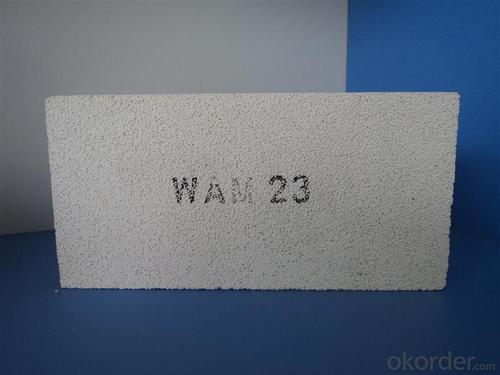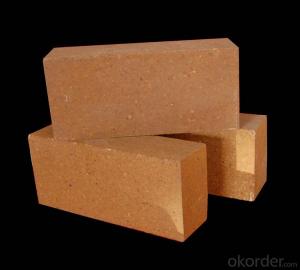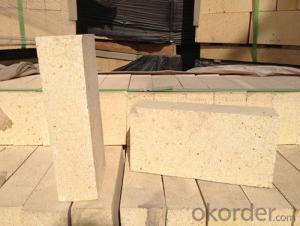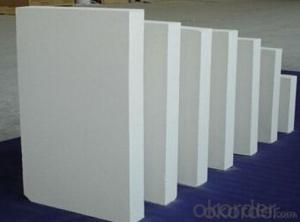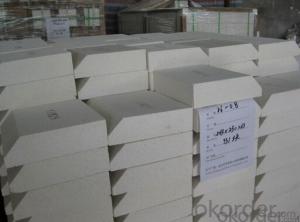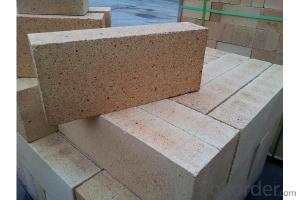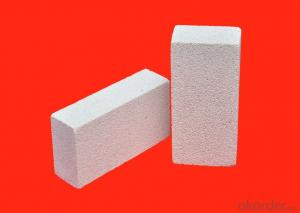Insulating Fire Brick - Refractory Mullite Insulating Fire Brick for Heating Furnace
- Loading Port:
- Qingdao
- Payment Terms:
- TT OR LC
- Min Order Qty:
- 2000 pc
- Supply Capability:
- 200000 pc/month
OKorder Service Pledge
OKorder Financial Service
You Might Also Like
1. Description of High Purity Corundum Brick:
High purity corundum brick SiO2<0.2%, Al2O3>99%, used in petrochemical industry furnace, gasification furnace and large fertilizer equipment, and more than 1600° C super high temperature furnace, liner of furnace. Long life and reliable in quality. We can make different kinds of shape products according the customer's drawing.
2. Main features of High Purity Corundum Brick
1. High compression strength.
2. Top high-temperature capability.
3. Excellent thermal stability.
4. Low thermal conductivity.
5. Powerful penetrating-proof capability.
6. Good erosion-resistance.
7. Long service life.
3. High Purity Corundum Brick Images:
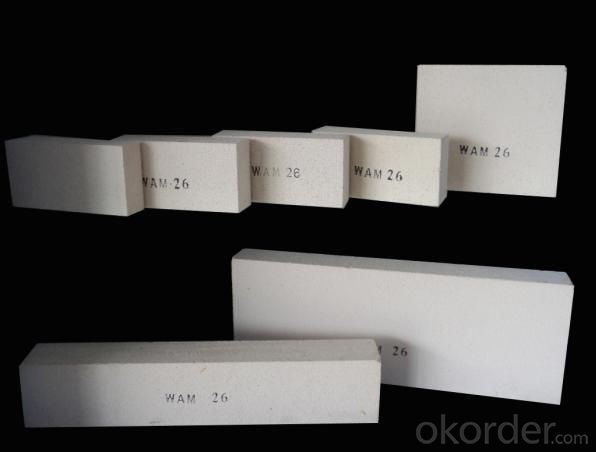
4. Applications of High Purity Corundum Brick:
Mullite lightweight brick plant can be in direct contact with the flame,this insulating brick can be used as linings or as thermal preservation layers in various industrial furnaces and kilns in metallurgical industry, ceramic industry, chemical industry, machinery industry.
such as blast furnace, hot blast stoves ,electric arc furnace, cement kiln,melting furnace, ignition furnace, flue, refining equipment, heating equipment and piping, regeneration device, gas furnace, soaking furnace, annealing furnace, heat reaction chamber and other thermal industrial equipment.
- Q: Are insulating fire bricks suitable for applications requiring low thermal conductivity?
- Insulating fire bricks are a suitable option for applications that require low thermal conductivity. They are specifically designed to possess low thermal conductivity, making them an ideal choice for situations where heat insulation is necessary. These bricks are crafted from lightweight and porous materials, like clay and other refractory materials, which offer exceptional insulation properties. The porous structure of insulating fire bricks captures air within the material, reducing heat transfer and resulting in minimal thermal conductivity. Consequently, they prove to be highly effective in kilns, furnaces, and other high-temperature settings where minimizing heat loss is essential. In summary, insulating fire bricks are a dependable selection for applications that necessitate low thermal conductivity.
- Q: What is the typical density of an insulating fire brick?
- The typical density of an insulating fire brick is around 0.8 to 1.2 grams per cubic centimeter.
- Q: Do insulating fire bricks require any special insulation blankets or jackets?
- Insulating fire bricks (IFBs) possess exceptional insulating properties, rendering them generally exempt from the need for specialized insulation blankets or jackets. However, in certain circumstances and environments, supplementary insulation may prove necessary. In cases where IFBs are subjected to high temperatures or extreme thermal conditions, the utilization of insulation blankets or jackets can prove advantageous, augmenting insulation capabilities and safeguarding against damage. These supplementary insulation materials serve to diminish heat loss, heighten energy efficiency, and prolong the lifespan of IFBs. Consequently, although not invariably essential, it is worthwhile contemplating the implementation of insulation blankets or jackets in specific scenarios to optimize the performance of insulating fire bricks.
- Q: Do insulating fire bricks require any special fireproof coatings?
- Special fireproof coatings are not necessary for insulating fire bricks. These bricks are specifically engineered to endure extreme temperatures and offer exceptional insulation without the need for extra coatings. They are crafted from refractory materials with elevated heat resistance and minimal thermal conductivity. Insulating fire bricks find wide usage in kilns, furnaces, fireplaces, and similar high-temperature settings that demand insulation. Their inherent properties enable them to withstand intense heat without requiring any further coatings or treatments.
- Q: Can insulating fire bricks be used for insulation in power plants?
- Yes, insulating fire bricks can be used for insulation in power plants. These bricks are specially designed to withstand high temperatures and provide excellent thermal insulation. They help in reducing heat loss and improving energy efficiency in various industrial applications, including power plants.
- Q: Are insulating fire bricks suitable for use in furnaces?
- Yes, insulating fire bricks are suitable for use in furnaces. Insulating fire bricks are specially designed to withstand high temperatures and provide excellent insulation properties. They are made from lightweight materials with low thermal conductivity, which helps to retain heat and reduce energy loss in the furnace. These bricks are able to withstand temperatures up to 3000°F (1650°C) and are commonly used in various types of furnaces, including kilns, incinerators, and industrial furnaces. Their insulating properties help to improve energy efficiency and reduce fuel consumption, making them a popular choice for furnace applications.
- Q: Can insulating fire bricks be used in the construction of combustion chambers for rocket engines?
- Yes, insulating fire bricks can be used in the construction of combustion chambers for rocket engines. Insulating fire bricks are specifically designed to withstand high temperatures and provide excellent thermal insulation. This makes them ideal for applications where extreme heat is involved, such as the combustion chambers of rocket engines. The primary purpose of insulating fire bricks in a rocket engine's combustion chamber is to protect the surrounding structure from the intense heat generated during combustion. By providing insulation, these bricks help to minimize heat transfer to the outer walls of the combustion chamber, preventing damage and ensuring structural integrity. Furthermore, insulating fire bricks are lightweight and have low thermal conductivity, allowing them to effectively retain heat within the combustion chamber. This is crucial for maintaining high combustion efficiency and optimizing rocket performance. In addition to their thermal properties, insulating fire bricks are also known for their durability and resistance to thermal shock. This is particularly important in rocket engine applications where rapid temperature changes can occur, such as during ignition or shutdown sequences. The ability of insulating fire bricks to withstand such thermal stresses is essential for the reliability and longevity of the combustion chamber. Overall, insulating fire bricks are a suitable choice for the construction of combustion chambers in rocket engines due to their high-temperature resistance, thermal insulation capabilities, lightweight nature, and durability.
- Q: What is the weight of insulating fire bricks?
- The weight of insulating fire bricks can vary depending on the specific type and size, but on average, they typically weigh between 2.5 to 3.5 pounds per brick.
- Q: Can insulating fire bricks be used in combination with other insulation materials?
- Insulating fire bricks can be utilized alongside other insulation materials to maximize their thermal insulation capabilities. Renowned for their exceptional thermal insulation properties, insulating fire bricks are commonly employed in kilns, furnaces, and fireplaces to effectively minimize heat transfer. However, attaining optimal thermal efficiency may necessitate additional insulation in certain instances. By merging insulating fire bricks with alternative insulation materials, the overall insulation performance can be significantly augmented. For instance, ceramic fiber blankets or boards can be employed in conjunction with insulating fire bricks to furnish supplementary insulation and bridge any gaps or joints between the bricks. This amalgamation aids in minimizing heat loss and elevating energy efficiency. Moreover, utilizing multiple insulation materials can confer additional advantages, such as heightened fire resistance, enhanced sound insulation, and fortified structural integrity. By skillfully combining diverse insulation materials, a more efficacious insulation system can be fashioned to meet the specific requirements of various applications. When combining different insulation materials, it is imperative to consider their compatibility and adherence to one another. Each material may possess distinct thermal properties, density, and installation prerequisites, necessitating strict adherence to the manufacturer's recommendations and guidelines for appropriate installation. In conclusion, the utilization of insulating fire bricks in conjunction with other insulation materials is instrumental in augmenting thermal insulation and overall performance across diverse applications. However, ensuring compatibility and adhering to proper installation guidelines is vital in order to achieve optimal outcomes.
- Q: Can insulating fire bricks be used in the construction of thermal insulation walls?
- Yes, insulating fire bricks can be used in the construction of thermal insulation walls. Insulating fire bricks are specially designed bricks that have a low thermal conductivity, which means they are excellent at preventing the transfer of heat. This makes them ideal for use in thermal insulation applications. When constructing thermal insulation walls, insulating fire bricks can be used as the primary material or in conjunction with other insulation materials such as foam boards or mineral wool. These bricks are typically lightweight, which makes them easier to handle and install. They also have high temperature resistance, allowing them to withstand the heat generated by fireplaces, ovens, or other heat-producing appliances. Insulating fire bricks offer several benefits for thermal insulation walls. They help to minimize heat loss or gain, thereby improving energy efficiency in buildings. They also help to reduce noise transmission, making them suitable for soundproofing applications. It is important to note that insulating fire bricks may not be suitable for all types of walls or building structures. Factors such as building codes, environmental conditions, and specific requirements of the project should be considered when determining if insulating fire bricks are the appropriate choice for thermal insulation walls. Consulting with a professional architect or engineer is recommended to ensure the best insulation solution for a specific construction project.
Send your message to us
Insulating Fire Brick - Refractory Mullite Insulating Fire Brick for Heating Furnace
- Loading Port:
- Qingdao
- Payment Terms:
- TT OR LC
- Min Order Qty:
- 2000 pc
- Supply Capability:
- 200000 pc/month
OKorder Service Pledge
OKorder Financial Service
Similar products
Hot products
Hot Searches
Related keywords




